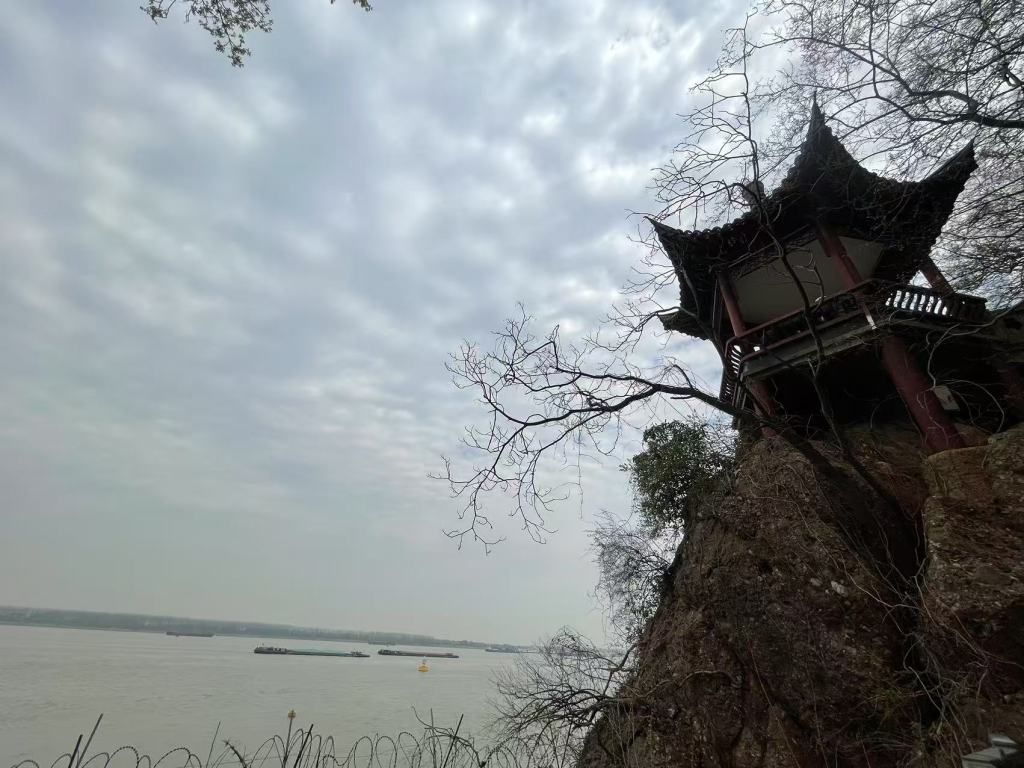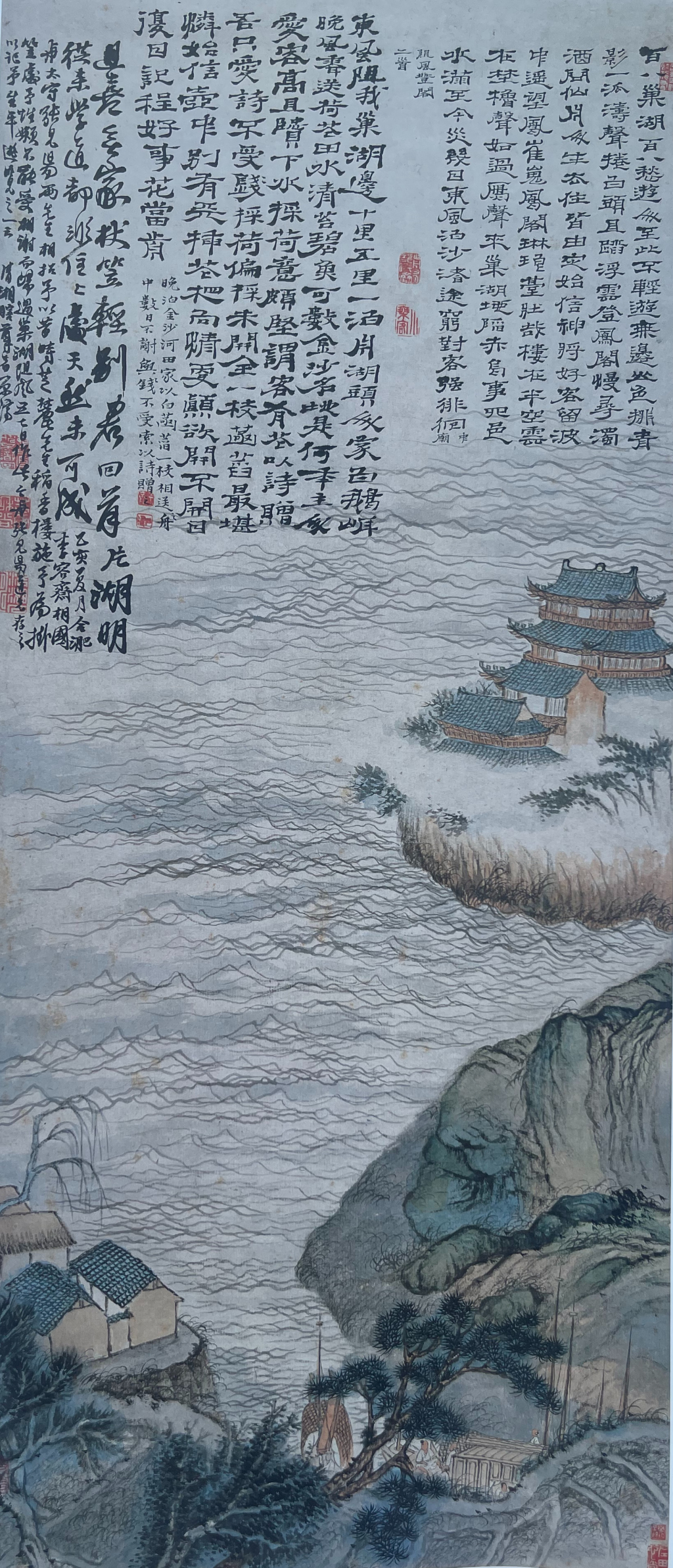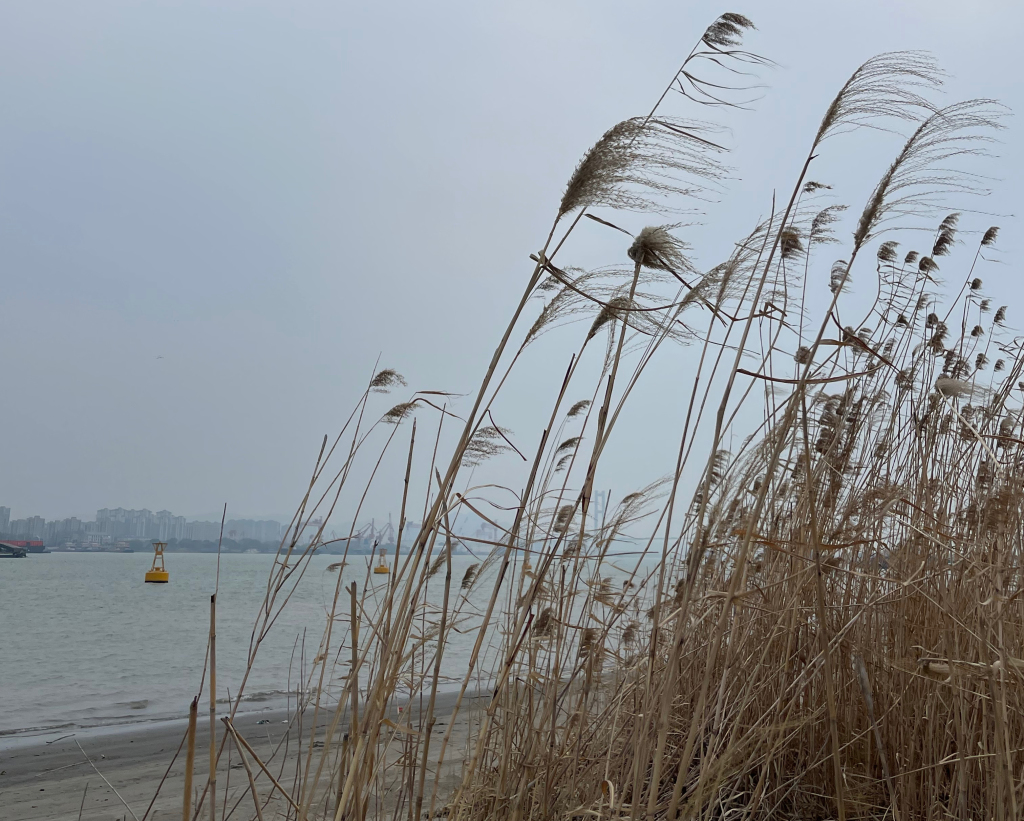
The river is surging, rushing eastward; the river is mighty, nourishing civilization. The Paper's "Cultural China Tour | Cultural Yangtze River" starts from Shanghai, goes up the river, walks along the Yangtze River, and tours the cultural veins of the Yangtze River.
This issue is about Nanjing Yanziji, which is known as the "first rock on the Yangtze River". Whether it is the place where the five horses crossed the river to the south, or the "Think about it, you can't die" admonition monument erected by Tao Xingzhi during the Republic of China, or the "Memorial to the Compatriots Who Died", all of them bear witness to the human sorrow between the river and the sky.
I have been to Nanjing countless times, but I have never been to Yanziji before, probably because it is located in the far suburbs. However, when I really made up my mind to go to Yanziji, which is known as the "No. 1 Rock on the Yangtze River", I couldn't help but sigh that this small rock on the Yangtze River named after the fist-shaped rock has such a vast realm and embodies countless human sorrows.
When we were about to reach Yanziji that day, there were still some remaining cherry blossoms, like layers of thin clouds that seemed to be there and not there, half-transparent and half-hidden on the avenue and hillside along the river, adding a kind of freshness to the world.
Arriving at the reef, it turned out to be only tens of meters high, lying quietly by the river, facing the sky on three sides, with jagged rocks as if a swallow is about to flap its wings, but the river is actually very calm. Whether it is the Ming Dynasty Zhang Dai's description of " the water is surging, the boatmen here, they quickly pull the hooks and pull the iron cables, and they cling to it like ants ", or the Qing Dynasty Li E's sentence "the rocks are like flying in the water, and the fishing nets are hanging on the cliffs in the clear sunlight", they have all become a thing of the past.

Swallow Rock
(one)
Walking eastward along the stone steps on the north bank, the cliffs facing the river are all purple-red sandstone and conglomerate - probably the Chibi. These rocks have been eroded by the waves of the river and are as steep as a knife. The stone steps meander up the wall. The Chinese tallow tree, elm, pine and cypress each struggle out of the cracks in the rocks. Their roots are like iron claws, clinging to the cracks in the rocks and stretching toward the water's edge, looking unrestrained and full of the meaning of metal and stone.

The legendary poem of Zhu Yuanzhang: "On Yanziji is a weight, what if the rainbow is the pole? The crescent moon in the sky is a hook, how much do I weigh my country!"
There are many poems inscribed on the cliffs, the most eye-catching of which is the poem by the legendary Ming Taizu Zhu Yuanzhang: "On Yanziji is a weight, with a rainbow as a rod? The crescent moon in the sky is a hook, weighing my mountains and rivers!"
Using the mountains and rivers as objects on the scale to weigh things is straightforward and bandit-like, mixed with a touch of imperial air, certainly not the tone of a scholar. However, the calligraphy is average, and it is not clear who wrote it. There is also a poem by Gong Banqian of the Qing Dynasty, "Leaving Swallow Rock and Going East Late in the Evening": "The river and the sky suddenly have no boundaries, and a boat is in the middle of the stream. The distant mountains are about to sink, but the setting sun has not yet set. I pity myself for being a guest for so long, and then I feel homesick. When I just woke up from the farewell wine, I see white gulls under the gray smoke." The calligraphy is average, and it reminds me of Xiao Xian and Lin Sanzhi who lived in Jinling, who did not even leave any traces of ink here.
Climbing up, you will reach the Guanlan Pavilion overlooking the river in just a few steps. It is suspended on a dangerous rock, with hexagonal eaves decorated with peeling red lacquer and mottled texture on the pavilion pillars. The pavilion is connected to the mountain road by a stone arch bridge, and four official script characters "River Wind and Mountain Moon" are carved on the huge rock beside the bridge.

Yanziji Guanlan Pavilion

Yanziji Rock Carving "Floating and about to fly"

Swallow Rock
The dangerous rocks beside the pavilion are some as if they were cut by an axe, some like rolling clouds, which are quite strange and bizarre. I remembered the words of Dadizi, "Search for all the strange peaks to make a draft", so I wrote a few words on paper.
At this time, leaning on the railing and looking east, the Yangtze River is like a big river, really calm and peaceful. The Second Yangtze River Bridge is faintly visible in the distance, and there is a touch of green on the other side of the river, which must be Baguazhou.
In the near distance there is a stone inscription with the cursive script "Floating as if about to fly" and in the far distance there are four large seal script characters "Swallow Rock Sunset", half hidden and half visible among the red cliffs and trees. At sunset, it is said that the whole cliff is like burning flames, and it is most spectacular when viewed from a boat in the river. Wang Yuyang's record of climbing up Swallow Rock wrote, "The setting sun is across the river, with more than ten Chinese tallow trees, red and yellow alternating. Thousands of leaves are falling, echoing with the evening tide." It is a really good sentence, almost like the artistic conception of "the waves of Dongting Lake and the falling leaves".
We can only imagine the “snowy waves”, “flying pearls and splashing jade” and the huge sound of the evening tide that the ancients described as the surging river.
(two)
Climbing up the stairs from Guanlan Pavilion, the stone steps are thin and hard, with many marks from chiseling.
When you reach the top of the mountain, the view is suddenly clear and the river is even wider. In the imperial stele pavilion on the top of the mountain, the three-character stele of "Yanziji" written by Emperor Qianlong is still preserved. This gentleman went to the south of the Yangtze River six times and climbed the rock five times. He wrote poems boasting that "the green walls and red cliffs are as beautiful as brocade". The calligraphy and words are all soft. In fact, it is not as straightforward as the admonition stele on the top of the mountain facing the river - the six characters "Think about it, you can't die" written by educator Tao Xingzhi, the font is grand and open, dark green like moss.

"Think about it, you can't die" written by Tao Xingzhi on the top of Yanziji
After reading the introduction, I learned that many people committed suicide by jumping into the river from this cliff during the Republic of China period. There is even a saying among the people in Nanjing: "The meat buns at Yanziji cost one liang (yang) each", with "yang" being a homonym for "liang", implying the large number of people who jumped into the river.
In 1927, when Tao Xingzhi founded Xiaozhuang Normal School (near Yanziji) in the northern suburbs of Nanjing, he heard from a rickshaw driver that a female student took a rickshaw to Yanziji, gave all the remaining money to the driver after paying the fare, and then jumped into the river alone. This incident made Tao Xingzhi particularly sad, so he decided to erect a sign to warn the world. It was originally a wooden sign, but later it was changed to a bluestone tablet. There was a detailed text on the back: "Death is heavier than Mount Tai, and death is lighter than a feather. Instead of jumping into the river for personal reasons, why not engage in rural education and work hard for the 430 million Chinese compatriots!" "Life comes for a great cause, and it should be left for a great cause. You are young and strong, you have a country to save and people to love, how can you commit suicide?"
It is said that the suicide rate dropped significantly after the monument was erected. It is common to see sad climbers lingering in front of the wooden sign for a long time before finally giving up on suicide.
The sorrow of troubled times, piercing and real, is condensed in this piece of bluestone. Reading it is worlds apart from the pretentious poems of Emperor Qianlong in the Imperial Stele Pavilion.
(three)

The triangular pavilion at Yanziji, a quick sketch by pen.
Going down from the top of the reef, passing a tree-lined path, you will see a triangular stele pavilion quietly perched on a dangerous cliff on the river beach.
The pavilion is built of white stone, shaped like a broken sword, facing the river. Inside is a monument with a very simple inscription: "Memorial to the Compatriots Who Died". The characters are in official script, with deep chisel marks. There are no tearful words, no accusations, only grim numbers. The postscript of the monument reads: "In December 1937, when the Japanese invaders captured the city, more than 50,000 compatriots died here..."
The monument was originally erected on the reed beach at Yanziji. After the fall of Nanjing in December 1937, a large number of soldiers and civilians gathered at Yanziji River Beach and tried to cross the river to escape northward. However, due to the blockade of the river by Japanese warships and the scarcity of ferries during the dry season, tens of thousands of people were trapped. The Japanese army then set up machine guns at the head of the reed beach and cooperated with the fire blockade of the river ships, resulting in the death of more than 50,000 people. Corpses piled up on the river beach and blood stained the river water.
It is said that the river water level rose and fell for three days, and the floating corpses still blocked the river bay, making it impossible for ships to pass...

Yanziji "Victims Memorial"
The thought was so sad that it was almost unimaginable... I picked some wild flowers nearby and presented them in front of the monument, then stood in silence for a moment.
The lower cliff is the river beach, which is fenced off with iron railings and wisteria winding around it, as if struggling. Only a few thin grasses between the cracks in the rocks are shaking in the wind. In the distance, the sound of river flutes can be heard, long and distant.
A great sorrow for heaven, earth and the human race.
(Four)
The river has been flowing for thousands of years, the scenery is the same, but the mountains and rivers are different.
The Wumadu Ferry, where the people of Jin Dynasty crossed the river to the south, is nearby. The so-called Wumadu Ferry refers to the fifth year of Yongjia in Jin Dynasty, when the Hu cavalry trampled Luoyang City, "surrounded and shot at it, more than 100,000 soldiers trampled on each other like a mountain, and no one escaped." The nobles crossed the river to the south in their formal attire, and the five princes of the Western Jin Dynasty first crossed the river here. Yanziji, as the first of the three cliffs on the Yangtze River, witnessed the migration of the people of Jin Dynasty to the south and the establishment of the Eastern Jin Dynasty in a hurry, and was also a river defense fortress to protect Jiankang. The Mufu Mountain (where Wang Dao set up his shogunate) not far away formed a natural barrier with Yanziji, which resisted many attacks by northern soldiers.
When the Jin people who migrated southward first arrived in Jiankang, they would invite each other to the new pavilion by the river every sunny day to have a gathering. According to the Biography of Wang Dao in the Book of Jin, Zhou Xi suddenly threw down his cup and sighed: "The scenery is the same, but the mountains and rivers are different!" Upon hearing this, all the celebrities looked at each other and burst into tears. Only Prime Minister Wang Dao changed color and said: "We should work together to help the royal family and recover the land of China. Why should we be prisoners of Chu facing each other!"
I just don’t know where the new pavilion is now?
I think of the "Sangluan Tie" left by Wang Xizhi after he moved south. The last few lines of the poem read, "The pain penetrates my heart, what can I do about it!" The great sorrow of the universe and life may have been magnified to the extreme there.

Yanziji River Beach
(five)
When I went down the mountain to look for Wuma Ferry, I accidentally found Yanba Ferry leading to the other side of the river, which is the ferry from Yanziji to Baguazhou.
The riverside area near the ferry is being developed, and the chaotic construction site has squeezed several old houses into a very cramped space. The gray two-story building has dusty doors and windows. The broken plaque on the lintel has long been cracked, but it still hangs stubbornly. When I read the "Nanjing Historical Building" nameplate hanging on the wall, I realized that this was a former fishing shop.

Historical buildings preserved along the river
Yanbadu is actually a small ferry. There are not many people waiting for the ferry. It is a good opportunity to arrive. After a short wait, fish sellers, vegetable buyers, and delivery riders came in one after another with noisy voices and in time. A rider in a blue uniform curled up his legs, with half a basket of live shrimps in the delivery box and his mobile phone screen on; in the middle, an old farmer laid a carrying pole across, with ducks' heads sticking out of bamboo cages at both ends, their yellow beaks opening and closing silently; there was also a young man wearing noise-canceling headphones, swiping his mobile phone screen with both hands... Mixed in this hurried crowd, gazing at the river from afar, the feeling was real and distant.
When you arrive at Baguazhou, you can see a large reed beach and one or two anglers sitting by the water.
When the boat was approaching the shore, three or four seagulls were startled and flew away over the water. Looking at the other side of the river, Yanziji had become a dot of light ink.

Yanziji River

